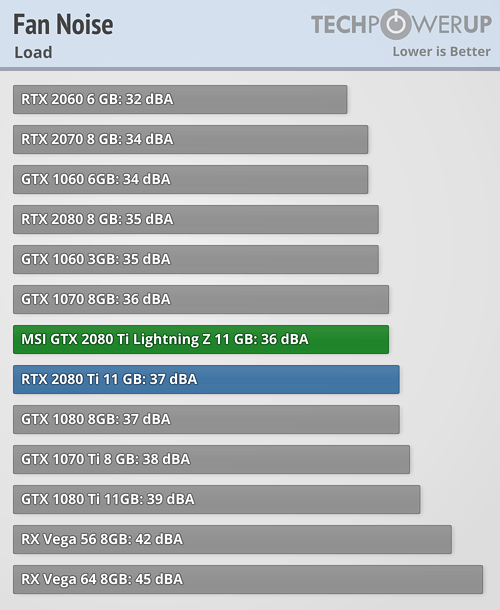 50
50
MSI GeForce RTX 2080 Ti Lightning Z 11 GB Review
Overclocking »Temperatures

| GPU Temperature Comparison | |||
|---|---|---|---|
| Idle | Load | Gaming Noise | |
| ASUS RTX 2080 Ti STRIX | 37°C | 65°C | 36 dBA |
| ASUS RTX 2080 Ti STRIX (quiet BIOS) | 46°C | 75°C | 31 dBA |
| EVGA RTX 2080 Ti FTW3 Ultra | 42°C | 64°C | 38 dBA |
| EVGA RTX 2080 Ti FTW3 Ultra (OC BIOS) | 42°C | 62°C | 40 dBA |
| EVGA RTX 2080 Ti XC Ultra | 50°C | 71°C | 35 dBA |
| MSI RTX 2080 Ti Duke | 53°C | 71°C | 34 dBA |
| MSI RTX 2080 Ti Gaming X Trio | 53°C | 74°C | 36 dBA |
| MSI RTX 2080 Ti Lightning Z | 40°C | 74°C | 36 dBA |
| NVIDIA RTX 2080 Ti Founders Edition | 42°C | 77°C | 37 dBA |
| Zotac RTX 2080 Ti Amp | 37°C | 65°C | 39 dBA |
Fan Noise
The MSI RTX 2080 Ti Lightning lacks the idle-fan-off feature we all love so much. However, with 26 dBA in idle, it is extremely quiet in that state and won't be audible when used in a case with any other actively cooled components. Still, given the massive heatsink, I do wonder why MSI didn't include fan-stop.
Gaming noise levels are slightly improved over the Founders Edition, but not by much—if you are looking for a low-noise option, other cards do better here. Given the card is targeted at overclockers, who don't worry much about fan noise, this shouldn't be a problem.


May 29th, 2024 00:18 EDT
change timezone
Latest GPU Drivers
New Forum Posts
- New Acer Helios 18 i9-14900hx constant throttle @ 94-100c (0)
- clear partitions and reset nvme firecudaa 520 (0)
- be quiet! Customer Service - so far is absolutely awesome. (4)
- Core counting (16)
- What's your latest tech purchase? (20689)
- COD went from gpu bound to CPU bound and running at 100% (2)
- 7950x idle question (9)
- Does a faster NVMe make any difference? (46)
- hdd-led/reset-sw/power/-quick connector adapter? (6)
- Windows as a Service (WaaS) is coming. (129)
Popular Reviews
- Upcoming Hardware Launches 2024 (Updated May 2024)
- Lian Li O11 Dynamic EVO XL Review
- Senua’s Saga: Hellblade II: DLSS vs. FSR vs. XeSS Comparison Review
- Senua's Saga: Hellblade II Performance Benchmark Review
- Ghost of Tsushima Performance Benchmark Review - 35 GPUs Tested
- Waizowl OGM Cloud Review
- Montech Titan Gold 1000 W Review
- Montech HyperFlow ARGB 240 AIO Review
- Ghost of Tsushima: DLSS vs. FSR vs. XeSS Comparison Review
- AMD Ryzen 7 7800X3D Review - The Best Gaming CPU
Controversial News Posts
- Intel Statement on Stability Issues: "Motherboard Makers to Blame" (272)
- AMD to Redesign Ray Tracing Hardware on RDNA 4 (227)
- NVIDIA to Only Launch the Flagship GeForce RTX 5090 in 2024, Rest of the Series in 2025 (154)
- AMD Hits Highest-Ever x86 CPU Market Share in Q1 2024 Across Desktop and Server (140)
- AMD RDNA 5 a "Clean Sheet" Graphics Architecture, RDNA 4 Merely Corrects a Bug Over RDNA 3 (139)
- NVIDIA RTX 5090 "Blackwell" Founders Edition to Implement the "RTX 4090 Ti" Cinderblock Design (108)
- AMD Ryzen 9 7900X3D Now at a Mouth-watering $329 (104)
- Core Configurations of Intel Core Ultra 200 "Arrow Lake-S" Desktop Processors Surface (101)
